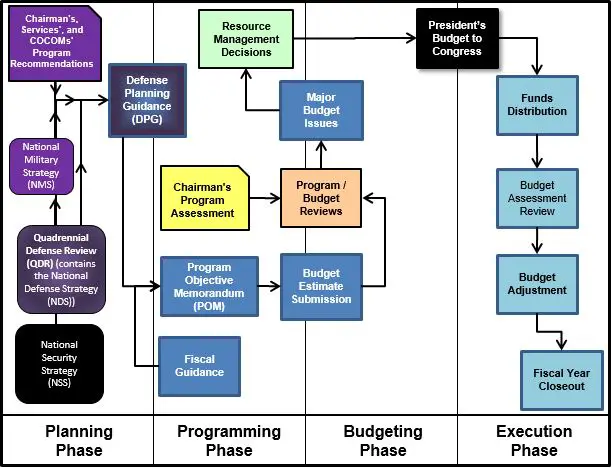 The National Defense Strategy (NDS) is used in the PPBE Process to establish the objectives for the plans for military force structure, force modernization, business processes, supporting infrastructure, and required resources (funding and manpower). Along with the Joint Capabilities Integration and Development System (JCIDS) Process, the NDS plays a key role in identifying the capabilities required by the warfighters to support the National Security Strategy (NSS). [1]
The National Defense Strategy (NDS) is used in the PPBE Process to establish the objectives for the plans for military force structure, force modernization, business processes, supporting infrastructure, and required resources (funding and manpower). Along with the Joint Capabilities Integration and Development System (JCIDS) Process, the NDS plays a key role in identifying the capabilities required by the warfighters to support the National Security Strategy (NSS). [1]
The NDS serves as the DoD’s capstone document in this long-term effort. It flows from the National Security Strategy (NSS) and informs the National Military Strategy (NMS). It also provides a framework for other DoD strategic guidance, specifically on campaign and contingency planning, force development, and intelligence. It reflects the results of the Quadrennial Defense Review (QDR) and lessons learned from on-going operations in Iraq, Afghanistan, and elsewhere. It addresses how the U.S. Armed Forces will fight and win America’s wars and how we seek to work with and through partner nations to shape opportunities in the international environment to enhance security and avert conflict.
The NDS describes our overarching goals and strategy. It outlines how DoD will support the objectives outlined in the NSS, including the need to strengthen alliances and build new partnerships to defeat global terrorism and prevent attacks against us, our allies, and our friends; prevent our enemies from threatening us, our allies, and our friends with weapons of mass destruction (WMD); work with others to defuse regional conflicts, including conflict intervention; and transform national security institutions to face the challenges of the 21st century. The NDS acts on these objectives, evaluates the strategic environment, challenges, and risks we must consider in achieving them, and maps the way forward.
2022 National Defense Strategy (NDS) Goals [1]
- Defending the homeland, paced to the growing multi-domain threat posed by the People’s Republic of China (PRC).
- Deterring strategic attacks against the United States, allies, and partners.
- Deterring aggression, while being prepared to prevail in conflict when necessary—prioritizing the PRC challenge in the Indo-Pacific region, then the Russia challenge in Europe.
- Building a resilient Joint Force and defense ecosystem.
Where the National Defense Strategy (NDS) fits into the PPBE Process

Figure: Planning Phase of the PPBE Process
AcqLinks and References:
- [1] 2022 National Defense Strategy (NDS)
- 2018 National Defense Strategy (NDS)
- 2018 National Defense Strategy Summary
- (Old) 2012 National Defense Strategy (NDS)
- (Old) 2008 National Defense Strategy (NDS)
- Defense Strategic Guidance “Sustaining U.S. Global Leadership: Priorities for 21st Century Defense” Jan 2012
- Website: Department of Defense (DOD) National Defense Strategy
Updated: 7/2/2023
